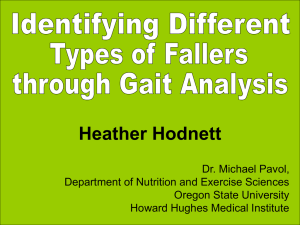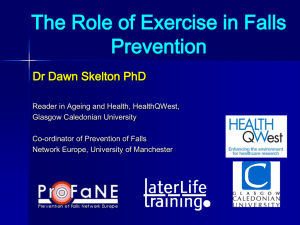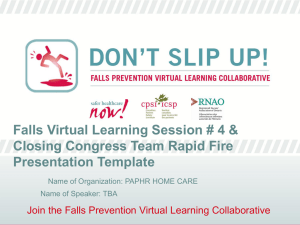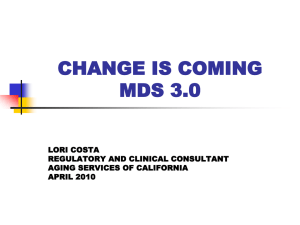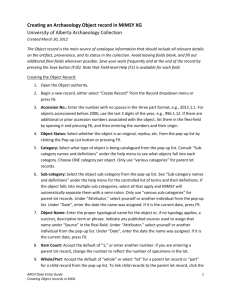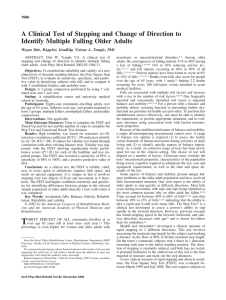Reducing Falls at United-Carsi Padrnos
advertisement
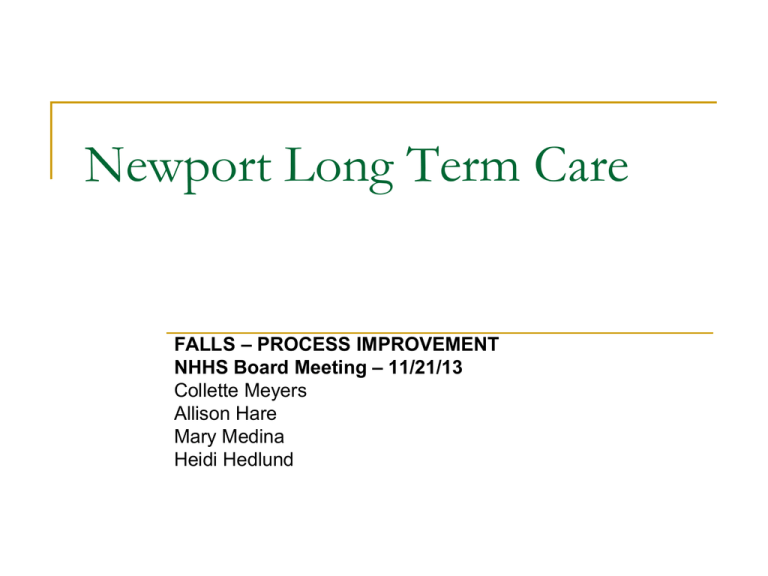
Newport Long Term Care FALLS – PROCESS IMPROVEMENT NHHS Board Meeting – 11/21/13 Collette Meyers Allison Hare Mary Medina Heidi Hedlund Process Improvement & Quality Teams Process improvement projects are set in motion 2 ways: A high priority goal or project drives the need for improvement, and/or A work team decides to tackle a situation they feel strongly about Small teams work together to: Identify a problem they would like to fix, set a goal Use data to create a picture of the situation/problem This creates a baseline, and Often points a finger at what is causing the problem Brainstorm potential counter-measures that seem highly likely to improve the problem Implement the chosen change Measure whether the change resulted in improvement Evaluate whether the improvement satisfies the goal, and begin again Practice “kaizen”, striving for continual improvement This process uses the principles of PDCA, or Closed Loop Corrective Action. It is based on measuring the output of an often-repeated process to ensure that any change really has improved the problem. Why Are We Talking About Falls? “Despite heightened national attention to …(falls in healthcare settings)…threats to reimbursement, and the best possible intentions, patient fall rates across the U.S. continue to escalate. Up to 50% of hospitalized patients are at risk for falls, and almost half of those who fall suffer an injury.” - “ Special Supplement to American Nurse Today – Best Practices for Falls Reduction: A Practical Guide” March 2011 Vol. 6 No. 2. Multiple Authors. More “Why” “…(Falls)….directly affect healthcare organizations’ cost per case and length of stay. The average hospital stay for patients who fall is 12.3 days longer, and injuries from falls lead to a 61% increase in patient care costs. - “ Special Supplement to American Nurse Today – Best Practices for Falls Reduction: A Practical Guide” March 2011 Vol. 6 No. 2. Multiple Authors. The Final “Why” Falls are likely our greatest threat to patient safety. Reducing falls increases patient quality of life significantly. Safety is our highest priority. Picture The Problem 3 Year Trend: Falls By Type 20 18 NON-INJURY Average falls/month 2011 = 10 INJURY 16 FRACTURE Average falls/month 2012 = 8 REPEAT FALLERS Average falls/month 2013 = 6 12 TOTAL FALLS 10 Average Daily Census: 2011 - 39.3 2012 - 42.4 2013 - 39.1 8 6 4 2 Ju l Au g Se p Oc t No v De c 1/1 3 2/1 3 3/1 3 4/1 3 5/1 3 6/1 3 7/1 3 8/1 3 9/1 3 10 /13 11 /13 12 /13 Ju l Au g Se p Oc t No v De c Ja n Fe b Ma r Ap r Ma y Ju n 0 Ja n Fe b Ma r Ap r Ma y Ju n Number 14 Time Period Too many falls (green) Too many injuries (blue) Too many repeat fallers (yellow) High variability, indicating lack of process What We’ve Done: 3 Phases PHASE 1: Joined the district-wide Skin & Falls Team and began sharing best practices cross-district. (2012) What We’ve Done: 3 Phases (cont.) PHASE 2: Implemented a Falls risk stratification process that helps identify at-risk patients and effective counter-measures (2nd Half 2012). Look at what happens on the graph!!! Picture The Problem 3 Year Trend: Falls By Type 20 18 NON-INJURY Average falls/month 2011 = 10 INJURY 16 FRACTURE Average falls/month 2012 = 8 REPEAT FALLERS Average falls/month 2013 = 6 12 TOTAL FALLS 10 Average Daily Census: 2011 - 39.3 2012 - 42.4 2013 - 39.1 8 6 4 2 Ju l Au g Se p Oc t No v De c 1/1 3 2/1 3 3/1 3 4/1 3 5/1 3 6/1 3 7/1 3 8/1 3 9/1 3 10 /13 11 /13 12 /13 Ju l Au g Se p Oc t No v De c Ja n Fe b Ma r Ap r Ma y Ju n 0 Ja n Fe b Ma r Ap r Ma y Ju n Number 14 Time Period 20% less falls per month (green) Injuries down (blue) Repeat fallers down (yellow) Less variability, indicating improved process What We’ve Done: 3 Phases (cont.) PHASE 3: POP UP Falls Prevention Program launched 8/13 with phenomenal results. Purpose of Pop-Up Program Prevent injury Improve quality of life Maintain dignity Provide a restraint free environment Essentials of Pop-Up Program Greater awareness via all-staff education Mindset of injury prevention At-risk patients identified w/ Pop-Up logo Posters to keep awareness high Emphasizes staff responsibility in fall/injury prevention Risk stratification still used Post-fall medication reconciliation Acronym Definition Planning Observation By ALL staff Rounding at high risk times Prevention Fall risk evaluation Environmental Hazards Visual identification (as determined by evaluation) Take the time it takes “Put your best foot forward” Wheelchair safety “U” Are The Solution Use of scripts “Is there anything else I can do for you? It’s no bother.” “Please call for assistance, we’re here to help you.” “I’ll be outside the bathroom door, please don’t get up without me.” “The call bell is within your reach.” Knowledge of individual residents Post-Fall Assessment Medication review RCA on Major Injury falls Goal: Create A Culture Of Safety This Skilled Nursing Facility’s goal is to promote personal freedom and safety for patients with impaired mobility. All staff will be knowledgeable and respond appropriately to patients identified with the POP-UP logo. Mindset of proactive injury prevention Going forward: In-house target of l.t.e. 5 falls/month Wrap Up 2013 YTD average of 6 falls per month 40% reduction in falls since 2011 In October we reported 3 falls, no major injury and no repeat fallers. The process we have in place is more predictable, and is performing at a better level. MDS reporting still shows Falls above state and national averages, due to a 275 day look-back period, making MDS a very important lagging indicator We are on track to meet our 2013 LEM goal We also track our “Days Without Falls” and have reached a record of 29 d.w.f. this month. A RECORD. A Multi-Year Effort: 40% Falls Reduction 3 Year Trend: Falls By Type 20 18 NON-INJURY Average falls/month 2011 = 10 INJURY 16 FRACTURE Average falls/month 2012 = 8 REPEAT FALLERS Average falls/month 2013 = 6 12 TOTAL FALLS 10 Average Daily Census: 2011 - 39.3 2012 - 42.4 2013 - 39.1 8 6 4 2 0 Ja n Fe b Ma r Ap r Ma y Ju n Ju l Au g Se p Oc t No v De c Ja n Fe b Ma r Ap r Ma y Ju n Ju l Au g Se p Oc t No v De c 1/1 3 2/1 3 3/1 3 4/1 3 5/1 3 6/1 3 7/1 3 8/1 3 9/1 3 10 /13 11 /13 12 /13 Number 14 Time Period MDS (Lagging Indicator) 2012/2013 Falls W/ Major Injury Benchmark 12.00% Percent of Patients 10.00% 8.00% Falls w/ Major Injury 6.00% National Avg. 4.00% State Avg. 2.00% 0.00% Q1'12 Q2'12 Q3'12 Q4'12 Q1'13 Q2'13 Q3'13 Q4'13 Time Period MDS reporting includes falls occuring within 275 days of current assessment For example, Q3’13 results include falls occuring as far back as Q4’12 2013 LEM Status 2013 FALLS VS LEM GOAL 90 80 70 Number 60 50 2013 CUM. FALLS 40 2013 LEM GOAL 30 20 10 0 1/13 2/13 3/13 4/13 5/13 6/13 7/13 Time Period 8/13 9/13 10/13 11/13 12/13 Measuring The Value To Patients As Approximated By The Savings To The Healthcare System They Are Accessing L.T.C. Patient Medicare/Medicaid/Reimburser Estimated System Savings: Using the quoted increase in length of hospital stay LTCU Falls Year Falls Per Month Falls Per Year 2011 2012 2013 10.33 7.58 6.10 123.96 90.96 73.2 LTC Inpatient Fully Additional Allocated Cost Per Length of Stay Day Per Article 250 250 250 12.3 12.3 12.3 Estimated Total Cost 381,177 279,702 225,090 Year over year system savings (101,475) (54,612) (156,087)
